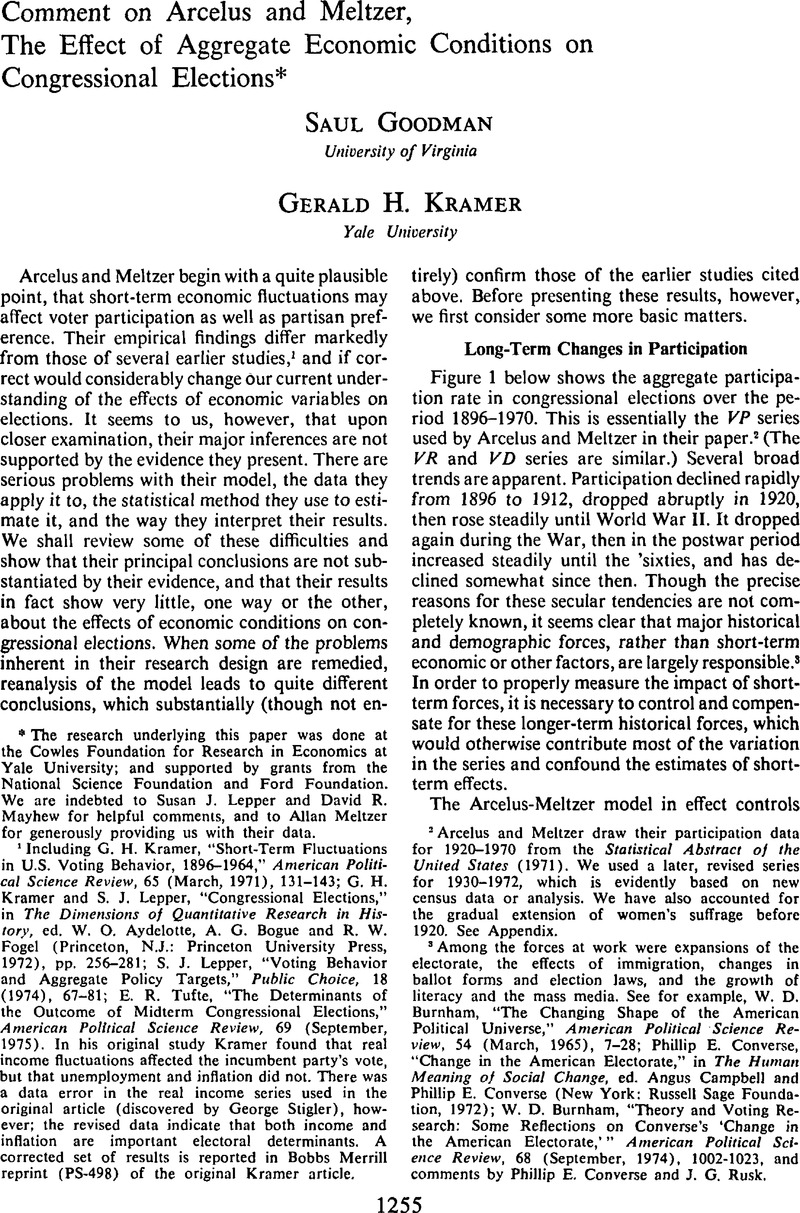Published online by Cambridge University Press: 01 August 2014

The research underlying this paper was done at the Cowles Foundation for Research in Economics at Yale University; and supported by grants from the National Science Foundation and Ford Foundation. We are indebted to Susan J. Lepper and David R. Mayhew for helpful comments, and to Allan Meltzer for generously providing us with their data.
1 Including Kramer, G. H., “Short-Term Fluctuations in U.S. Voting Behavior, 1896-1964,” American Political Science Review, 65 (03, 1971), 131–143 CrossRefGoogle Scholar; Kramer, G. H. and Lepper, S. J., “Congressional Elections,” in The Dimensions of Quantitative Research in History, ed. Aydelotte, W. O., Bogue, A. G. and Fogel, R. W. (Princeton, N.J.: Princeton University Press, 1972), pp. 256–281 Google Scholar; Lepper, S. J., “Voting Behavior and Aggregate Policy Targets,” Public Choice, 18 (1974), 67–81 CrossRefGoogle Scholar; Tufte, E. R., “The Determinants of the Outcome of Midterm Congressional Elections,” American Political Science Review, 69 (09, 1975)CrossRefGoogle Scholar. In his original study Kramer found that real income fluctuations affected the incumbent party's vote, but that unemployment and inflation did not. There was a data error in the real income series used in the original article (discovered by George Stigler), however; the revised data indicate that both income and inflation are important electoral determinants. A corrected set of results is reported in Bobbs Merrill reprint (PS-498) of the original Kramer article.
2 Arcelus, and Meltzer, draw their participation data for 1920-1970 from the Statistical Abstract of the United States (1971)Google Scholar. We used a later, revised series for 1930-1972, which is evidently based on new census data or analysis. We have also accounted for the gradual extension of women's suffrage before 1920. See Appendix.
3 Among the forces at work were expansions of the electorate, the effects of immigration, changes in ballot forms and election laws, and the growth of literacy and the mass media. See for example, Burnham, W. D., “The Changing Shape of the American Political Universe,” American Political Science Review, 54 (03, 1965), 7–28 CrossRefGoogle Scholar; Converse, Phillip E., “Change in the American Electorate,” in The Human Meaning of Social Change, ed. Campbell, Angus and Converse, Phillip E. (New York: Russell Sage Foundation, 1972)Google Scholar; Burnham, W. D., “Theory and Voting Research: Some Reflections on Converse's ‘Change in the American Electorate,’” American Political Science Review, 68 (09, 1974), 1002–1023 CrossRefGoogle Scholar, and comments by Phillip E. Converse and J. G. Rusk.
4 See Johnston, J., Econometric Methods (New York: McGraw-Hill, 1972), pp. 168–169 Google Scholar.
5 For example, Key, V. O., The Responsible Electorate (Cambridge: Belknap Harvard, 1966)CrossRefGoogle Scholar.
6 This is the specification used in Kramer, “Short-Term Fluctuations,” but others would do as well.
7 Ibid., p. 139.
8 For a discussion of the identification problem in a slightly different context, see Koopmans, T. C., “Identification Problems in Economic Model Construction,” in Studies in Econometric Method, ed. Hood, W. C. and Koopmans, T. C. (New York: Wiley, 1953)Google Scholar.
9 See Johnston, , Econometric Methods, p. 159ffGoogle Scholar.
10 The positive correlation is noted by Arcelus and Meltzer (footnote 17, p. 11).
11 This follows from Johnston, pp. 239-241.
12 Since Var(b – b′) = Var(b) + Var(b′) - 2 Cov(b, b′), for any two estimators b and b′.
13 Using the original Arcelus-Mellzer data (with a corrected C/P series), we reestimated the VP, VD and VR equations. The salient discrepancies between the two sets of estimates are summarized in the table below.
14 Arcelus and Meltzer define the rate as (Pi – Pi-1)/Pi′ rather than the conventional specification (p, – pi-1)/pi-1 .
15 The VD and VR relations involve the same set of regressors. Under these conditions the Zellner procedure reduces to the one used by Arcelus and Meltzer, of separate OLS estimation of each individual equation. Cf. Johnston, , Econometric Methods, p. 240 Google Scholar.
16 Theil, Henri, Principles of Econometrics (New York: Wiley, 1971), p. 282ffGoogle Scholar.
17 In principle the VR – VD, VP system are “seemingly unrelated regressions” to which the Zellner GLS procedure should be applied. The covariance between the disturbances, however, is small; if we let e 2′ e 2′, e 3′ e* be the disturbances in the VR, VD, VP, VR – VD relations respectively, then e 2, = e 1 + e 2, and e* = e 1 – e2. Hence
where Σ1 2 and Σ2 2 are the variances of e 1 and e 2 respectively. Unconstrained OLS estimation of the VR, VD relations indicates σ2 2 and σ2 2 are nearly equal, so Cov(e*,e 3) will be quite small, and the GLS estimates will be very close to our ordinary least squares estimates. See Johnston, , Econometric Methods, pp. 238–241 Google Scholar.
18 See for example, Theil, pp. 255-256.
19 See, for example, Kelly, Stanley Jr., Ayres, R. E. and Brown, W. G., “Registration and Voting: Putting First Things First,” The American Political Science Review, 61 (06, 1967), 359–377 CrossRefGoogle Scholar.
20 The evidence on this presented by Bloom and Price is impressive, though they consider only the income variable. Some very preliminary analysis we have done suggests that the asymmetry they found becomes much smaller if the effect of inflation is controlled for.
Comments
No Comments have been published for this article.